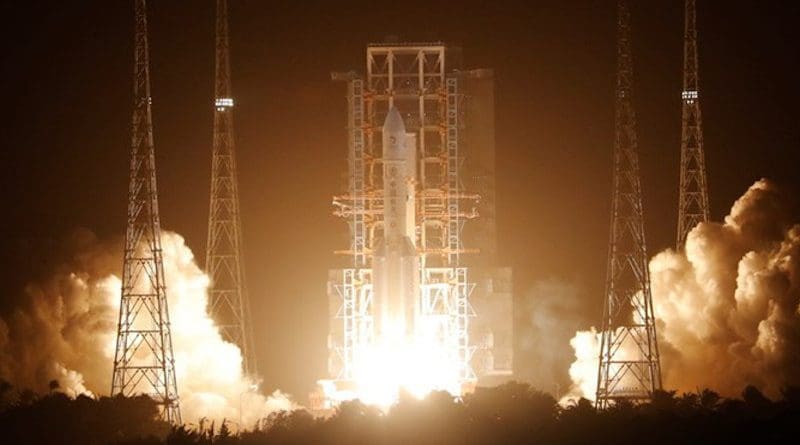Can China’s Commercial Space Sector Achieve Lift Off? – Analysis
By R Lincoln Hines*
China announced in 2014 that it would allow private investment into its traditionally state-dominated space sector. This decision led to rapid proliferation of Chinese space companies — creating one of the fastest growing commercial space sectors on the planet. Yet, despite the explosive growth of China’s commercial space sector, space companies there face daunting challenges both domestically and globally.
China’s space industry is dominated by two state-owned enterprises (SOEs): the China Aerospace Science and Industry Corporation (CASIC) and the China Aerospace Science and Technology Corporation (CASC). These massive SOEs and their subsidiaries have allowed China to send humans into outer space and a probe to the far side of the Moon. Like in the United States, the emergence of commercial space companies — those which seek profits rather than simply implementing government goals — is changing the landscape of China’s space industry.
By focussing on private investment, commercial space companies may be more agile than SOEs in navigating market pressures, and thus produce more cost-effective and innovative capabilities. For example, in the United States, SpaceX has pioneered reusable rocket technology which could reduce costs for spaceflight.
But critics claim the opposite is happening in China. Propped up by the state, Chinese companies are insulated from market pressures. This protection might even allow Chinese space companies to provide more affordable launches, satellites and imaging services than their genuinely private American counterparts.
But the reality is more complex than either of these arguments suggest. China’s commercial space sector consists of state-owned, mixed-ownership and private companies. Many of these companies are also supported by provincial governments rather than Beijing, which provides for considerable autonomy in their operations.
China’s commercial space companies play a largely complementary role to government-sponsored activity. Whereas SOEs are tasked with high-profile projects such as landing on the Moon and Mars, commercial companies fill niche gaps overlooked by state players. The majority of Chinese space companies focus on building satellites and their components, including microsatellites and small satellite constellations in low Earth orbit. Exceptions include the firms Landspace, iSpace and OneSpace, which focus on small launch vehicles.
Yet, expanding beyond this marginal role in China’s overall space ecosystem may bring China’s private space companies into competition with the SOEs that currently dominate the industry. Insulated from market pressures, these SOEs tilt the playing field to their advantage over commercial space companies. And although it may be in China’s economic interests to increase competition domestically, it is hard to imagine the Chinese Communist Party (CCP) abandoning its national champions, which have allowed it to accrue prestige with domestic audiences.
Although some analysts worry about Chinese space companies receiving unfair government assistance, the government may actually not have done enough to promote the country’s space companies. Unlike other major space powers, China does not have a national space law. Without one, commercial space companies and industry investors alike are unclear about their legal rights and restrictions and uncertain about the market. It is perhaps for these reasons that Chinese companies are less bullish about their prospects than pundits. Chinese companies have far less confidence about the trajectory of China’s commercial space industry than outside observers.
Even greater constraints lie abroad. Regardless of how independent Chinese commercial space companies may be from the central government, they have an inherent branding problem. There is a widespread perception in the United States among commercial space actors that Chinese space companies receive nearly unlimited access to central government funding. This perception that Chinese space companies are simply an extension of the state may repel potential international customers wary of interacting with the CCP or the People’s Liberation Army.
This creates problems for Chinese space companies seeking to expand their operations outside of Chinese borders. While countries with close geopolitical ties to China may readily welcome business opportunities with Chinese space companies, countries with more adversarial relations with China may be reluctant to engage with its space companies no matter the price. For Chinese space companies, the looming presence of China’s government constrains its global market potential. More concretely, export controls and other restrictions by the United States and its allies and partners place hard limits on China’s abilities to import space technologies and expand into international markets.
Still, this may only be a short-term constraint on China’s commercial space sector. In the long term, it may well benefit from focusing, by necessity, on indigenous innovation.
While it is too soon to determine the trajectory of China’s complex and evolving commercial space sector, its strengths are often exaggerated and its limitations ignored. Chinese space companies have a long way to go before they can compete with their American counterparts. Exaggerated threats about China’s commercial space sector will only further strain an increasingly tense US–China relationship — both on Earth and in space.
*About the author: R Lincoln Hines has a PhD in Government from Cornell University.
Source: This article was published by East Asia Forum

